The Patron Saints of the Culinary Arts

Looking for a little help in the kitchen? How about turning to a patron saint? You probably won’t experience a miraculous washing of the dishes, but you may find your food and feasting filled with unexpected graces.
The Church has a rich tradition of assigning saints as special guardians and protectors of different aspects of our lives. The culinary arts are no exception. Here are a few of the many patron saints to call on for assistance in the kitchen:
Saint Lawrence
Died 258 A.D.
Feast day: August 10
Patron saint of cooks
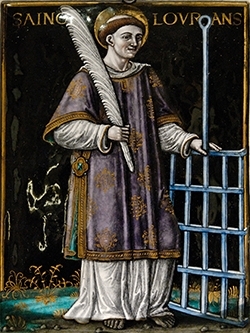
If every steak on the grill could be as considerate as St. Lawrence, there’d be less overcooked meat in the world. As he lay on a gridiron set over coals to be roasted to death, this early Christian martyr allegedly told his executioners, “Turn me over, I’m done on this side.”
There’s another story that illustrates the generosity of soul which makes St. Lawrence an excellent patron saint for cooks preparing meals. When the emperor of Rome ordered the execution of all bishops, priests, and deacons, Lawrence, a deacon in charge of distributing goods to the poor, was ordered to hand over all the treasures of the church. Lawrence asked for three days to collect the bounty, and in that time gave away the church’s wealth to the poor. He returned to the emperor with a contingent of the city’s poor, crippled, blind, and sick, and said, “Here is the Church’s treasure.”
Saint Martha
Died 84 A.D
Feast day: July 29
Patron saint of cooks, wait staff, and housewives
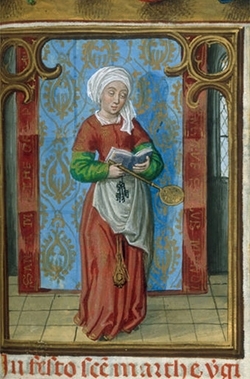
St. Martha, sister of Lazarus and Mary, is a great patron saint of cooking and hospitality because she served dinner to Jesus himself. Although Jesus admonished her to stop worrying about getting kitchen help from her sister, he surely enjoyed her efforts.
The Gospel of John records another meal Jesus ate at her house, six days before his last Passover: “And they made him supper there; and Martha served” (John 12: 2). As the host of the most important dinner guest ever to grace a party, who better to call on for help before the guests arrive?
Saint Elizabeth of Hungary
1207-1231
Feast day: November 17
Patron saint of bakers
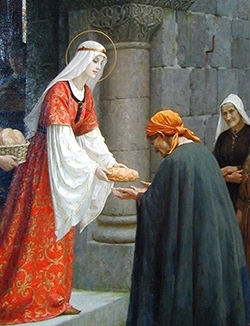
St. Elizabeth is often depicted with loaves of bread because she spent so much of her life feeding the poor. The daughter of the king of Hungary, Elizabeth was married at 14, widowed at 20 with three children and died at 24. In her short life she used her position to serve the poor, rejecting the luxuries of courtly life to feed the hungry and attend to the sick, even putting a leper in her own bed.
St. Elizabeth built a hospital and monastery, but most relevant to her patronage of bakers is the gift of grain she gave to Germany during a famine.
Saint Honore
Died in 600
Feast day: May 16
Patron saint of bakers and pastry chefs
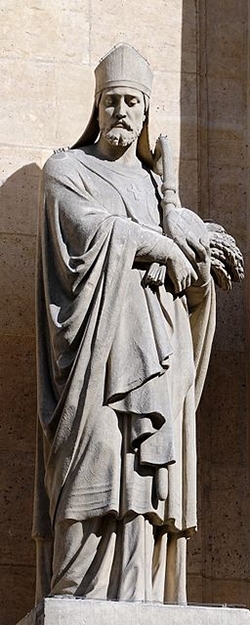
Photo by Marie-Lan Nguyen
Long revered by French bakers, St. Honore was a bishop in France in the sixth century. His original connection to baking stems from a story about his childhood nursemaid. When she was told he was named bishop, she said she’d only believe it if the wooden paddle she was using to bake bread grew into a tree. The paddle fell to the ground, grew roots and blossomed into a blackberry tree that supposedly was still revered a thousand years later.
St. Honore’s position as patron saint of bakers was solidified in 1202 when land that a Parisian baker donated to build a church in his honor became the site of the bakers’ guild. Even today many pastry shops and boulangeries are named after him. In Paris his feast day is celebrated with a three-day festival of bread.
The eponymous Gateau St. Honore, a confection of puff pastry, cream puffs, pastry cream, and caramelized sugar, is traditionally used as a First Communion cake in France.
Saint Anthony of Egypt
250-356
Feast day: January 17
Patron saint of butchers
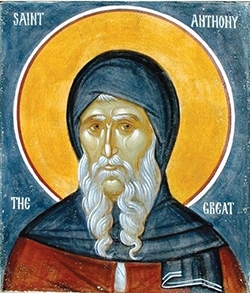
St. Anthony was a hermit, not a butcher, and his ascetic lifestyle and practice of bodily mortification probably left little opportunity for eating meat. But he’s often portrayed with a pig at his feet, hence his association with butchers and bacon, in particular.
St. Anthony’s relation to pigs is something of a mystery. One theory is that pig fat was used in the Middle Ages to treat itchy rashes and St. Anthony is the patron saint of skin diseases. Another theory holds that pigs are sometimes used as symbols of the devil, and St. Anthony was a spiritual healer who endured epic battles with demons.
The saint was born to a wealthy family, but gave up his property after his parents died. He moved to the desert and lived alone, or tried to, even as pilgrims flocked to his cell for healing and counsel. He lived to be 105 years old.
Saint Hildegard
1098-1179
Feast Day: September 17
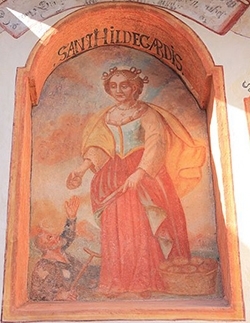
St. Hildegard is not officially the patron saint of anything. But a mystic nun who wrote recipes and developed a nutritional philosophy belongs on any list of Catholic saints associated with the culinary arts.
St. Hildegard’s interest in the healing properties of food makes her a very modern saint. To promote health and cheerfulness and to slow the aging process, St. Hildegard recommended a diet high in foods she considered most nutritious (spelt, fennel, chestnuts, chickpeas, meat from animals fed grass and hay, certain fruits and vegetables) and low in harmful ones (strawberries, eel, refined sugar, and sausage, to name a few). Among her dietary principles were that breakfast should be eaten late and served warm, and that a walk should be taken after dinner.
A brilliant woman, she also invented an alphabet, composed sacred music, founded monasteries, wrote books on medicine and botany, spoke out against corruption, travelled through Germany as a preacher and healer, and corresponded with popes and emperors. Never formally canonized, St. Hildegard was recently named by Pope Benedict a Doctor of the Church, one of only four women to be so named.
St. Hildegard’s recipe for “Cookies of Joy” is still used today. She encouraged bakers to eat the cookies often: “They will reduce the bad humors, enrich the blood, and fortify the nerves,” she wrote.
Saint Nicholas of Tolentino
1245-1305
Feast Day: September 10
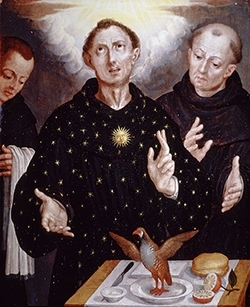
Painting attributed to Alonso López de Herrera
Another saint for the modern age is St. Nicholas, unofficially the patron saint of vegans and vegetarians. St. Nicholas, an Augustinian friar, took a vow not to eat meat. He was known as a kind, gentle man who performed many miracles, such as curing the blind and sick and raising the dead.
Once when he was gravely ill, the Blessed Mother appeared to him and told him he’d be cured if he ate bread dipped in water. He did as she instructed and recovered. Thereafter he gave bread dipped in water to the sick, and today, certain Augustinian monasteries practice the blessing of St. Nicholas bread.
There are several stories of miracles related to his vegetarianism. Once when he was presented with a dish of chicken, he prayed over his plate and the chickens flew out the window. In another version of this story, the chickens transformed into roasted vegetables.
Saint Drogo
1105-1186
Feast Day: April 16
Patron saint of coffee and coffee makers
This Flemish shepherd and hermit was born to nobility, orphaned at a young age, and dedicated himself to a life of pilgrimages and extreme penance.
As far as we know, St. Drogo never drank coffee. He lived solely on barley, water, and the Eucharist until he died. His connection to coffee is that he was said to “bilocate,” working in the fields and going to Mass at the same time. Bilocation would require enormous energy, and coffee is an energy booster.
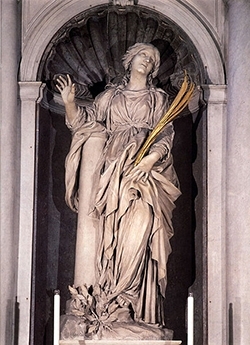
Photo by WikiPaintings under the Creative Commons License.
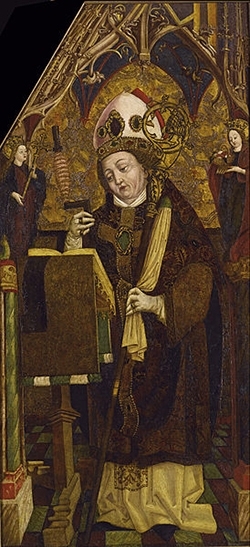
As a final note:
If you’ve overindulged at the table, you can turn to St. Erasmus, the patron saint of abdominal pain, or St. Bibiana, the patron saint of hangovers.
Saints Cards

In Finding God Grade 6, students are encouraged to make a card of their favorite saint, and of themselves, showing how they are becoming saints.
Here’s how to use this activity in your classroom.
- On the front of the card, draw a picture of the saint and write a prayer. Then on the back of the card add something about the accomplishments of the saint.
- Remember that we are all in communion with the saints, so make a second card for yourself. Draw your picture on the front of the card, and on the back, add your name, date and place of birth.
- Then write some of the good things you have done to show how you are also becoming a saint. Have you helped others? Have you done any service for your community? Do you pray regularly? Write all of those things and any others you can think of.
This activity is adapted from Finding God Grade 6 (2013), SE, page 179.

